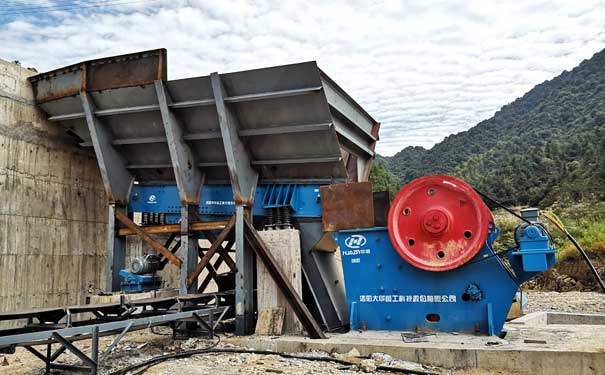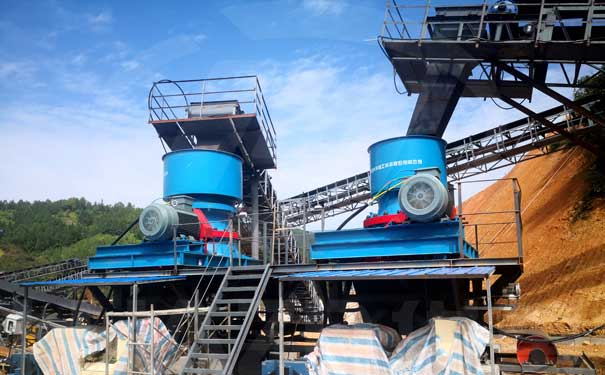In recent years, the market demand for sand and gravel aggregates has increased day by day. Many investors are very optimistic about the sand and gravel industry and are eager to try. The process design of the sand and gravel aggregate production line often becomes the primary concern of investors when investing in construction, generally from the aspects of equipment selection, workshop layout, and environmental protection. The sand aggregate production line can be simply summarized as: crushing, screening and storage.
1. Pre-screening and feeding equipment
Aggregate products have relatively high requirements for soil content. Generally, a vibrating feeder that can remove soil from the source is equipped before the material enters the rough fracture. The vibrating feeder is mainly used for continuous and uniform feeding before the coarse crusher. While feeding, the material is coarsely screened according to the preset bar gap size.
When the content of soil in the raw material is small and the raw material is relatively dry, the size between the screen bars of the vibrating screen feeder can be adjusted to an appropriate value, and the soil can be screened out after the material passes through the feeder;
When the raw material contains a lot of soil or the raw material is more viscous, you need to consider increasing the size of the feeder screen. Most of the soil-containing waste is screened and then passed through a circular vibrating screen for screening. The sieve is clean, and the stones on the circular vibrating screen can be re-entered into the secondary crusher to be crushed.
2. Crushing equipment
Crushing equipment is generally divided into coarse crusher (jaw crusher, hammer crusher), medium and fine crusher (cone crusher, impact crusher), sand shaping crusher (vertical impact crusher, vertical type composite crusher, vertical shaft impact crusher).
For materials, it is necessary to distinguish the medium and fine crusher, that is, the cone crusher and the impact crusher. For hard rock, the hardness and abrasiveness index is high. Cone crusher is recommended for secondary crushing. The cone crusher adopts the principle of laminated crushing, which has high wear resistance of vulnerable parts; for limestone, which has moderate hardness and abrasiveness index, counterattack is recommended. The impact crusher and impact crusher adopt the principle of impact crushing, and the liner has low wear resistance.
It should be noted that hammer crushers are rarely used in the production of general aggregates. Although the hammer crusher is a one-stage crushing process, the process is simple, but after the hammer is broken, the yield of the large aggregate is low, it is easy to be crushed, and there are many powder materials. The finished aggregate will produce micro cracks and reduce the compressive strength, which affects the aggregate quality, affect sales.
3. Screening equipment
Generally, linear vibrating screen and circular vibrating screen are used for screening equipment in the aggregate industry. In actual production, the choice of circular vibrating screen or linear vibrating screen mainly depends on the type of material handled by the user and the application field. The purpose of screening is different, and the equipment selected is also different. There is no essential difference between the style and structure of the circular vibrating screen and the linear vibrating screen. The materials are screened through the vibration of the screen surface, but the difference of the vibration track will directly affect the screening purpose.
4. Finished product yard layout
In response to the national environmental protection policy, the storage of finished aggregates can be in sheds or warehouses. In order to reduce the secondary dust during storage in the shed, if the terrain height difference is available during the layout, try to design the loading belt conveyor under the material pile. For the dust removal of the finished aggregate storage and unloading point, water spray dust removal can be selected according to the on-site water source situation; the factory area in the cold area of the north of my country with tight water source can also reduce dust emissions by building storage and storage sheds.
5. Environmental issues
The environmental pollution caused by sand and gravel production lines is mainly dust, noise and sewage generated during the production process.
Dust is generated in the entire process of aggregate production. In order to effectively control the amount of dust emission, the design is designed to minimize the dust-raising link in the process, select equipment with less fugitive dust, and use conveying and feeding equipment with good airtight performance. Pay attention to the shape and angle of the material pipe when designing the material pipe connected to the equipment to minimize the drop.
Noise control, first, chooses low-noise equipment as far as possible from the equipment selection; second, arrange the noisy equipment in a closed workshop.
Sewage treatment: After pretreatment in septic tanks, domestic sewage is used as water for greening, farmland irrigation, etc., and is not discharged; water for spray dust removal belongs to consumption water and evaporates naturally after dust removal.






